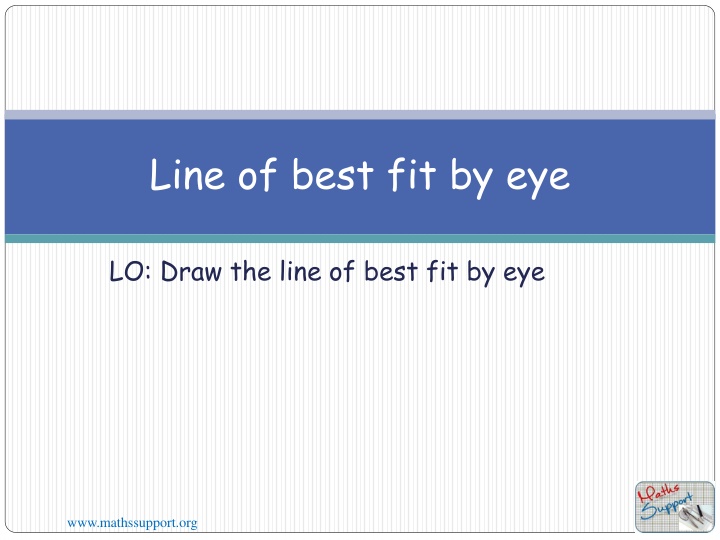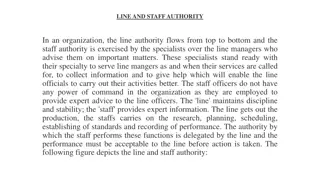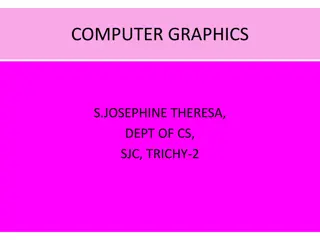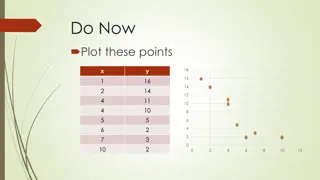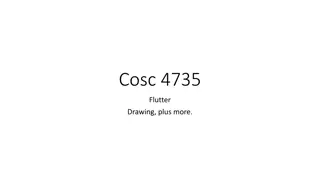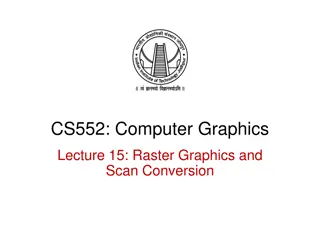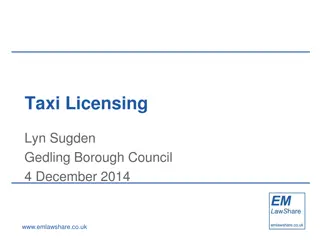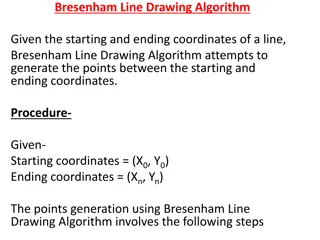Drawing Line of Best Fit for Bivariate Data
A line of best fit can be drawn by eye for bivariate data to show correlation. Understanding the steps is essential; finding means, plotting the mean point on a scatter diagram, and drawing a line through the point that fits the trend. Interpolating between poles is generally reliable, but extrapolating outside poles can lead to inconsistencies. Example data of student marks in Maths and Science tests is used to illustrate scatter graph plotting and the concept of a line of best fit.
Download Presentation

Please find below an Image/Link to download the presentation.
The content on the website is provided AS IS for your information and personal use only. It may not be sold, licensed, or shared on other websites without obtaining consent from the author.If you encounter any issues during the download, it is possible that the publisher has removed the file from their server.
You are allowed to download the files provided on this website for personal or commercial use, subject to the condition that they are used lawfully. All files are the property of their respective owners.
The content on the website is provided AS IS for your information and personal use only. It may not be sold, licensed, or shared on other websites without obtaining consent from the author.
E N D
Presentation Transcript
Line of best fit by eye LO: Draw the line of best fit by eye www.mathssupport.org
Drawing a Line of Best Fit A line of best fit can be drawn to data that shows a correlation. The stronger the correlation between the data, the easier it is to draw the line. The line of best fit should pass trough the mean point ( ?, ?) ( ?, ?) The line can be drawn by eye and should have roughly the same number of data points on either side. The sum of the vertical distances above the line should be roughly the same as those below. www.mathssupport.org
Drawing a Line of Best Fit For a bivariate data set involving x and y, we use these steps to find the line of best fit by eye Find the means ?and ?of the xandyvalues respectively. Plot the mean point ( ?, ?) on a scatter diagram of the data. Step 3: Step 1: Step 2: Draw a line through the mean point which fits the trend of the data and which has about as many points above the line as below it. The line of best fit is a linear model for the relationship between the variables. We can use it to estimate the value of one variable for any given value of the order ( ?, ?) www.mathssupport.org
Drawing a Line of Best Fit Given a bivariate data set, the data values with the lowest and highest value of x are called the poles. If we use the values of x in between the poles to estimate y, we say we are interpolating between the poles If we use the values of x outside the poles to estimate y, we say we are extrapolating outside the poles Upper pole Lower pole As a general rule, it is reasonable to interpolate between the poles, but it is unreliable to extrapolate outside the poles interpolation extrapolation extrapolation www.mathssupport.org
Ten students were surveyed to find the number of marks they received in a Maths test and a Science test. The results were: 40 79 60 65 30 73 56 67 45 85 Science 48 91 70 71 50 85 65 75 60 95 Maths (a) Plot a scatter graph for this data. 100 90 80 70 Maths 60 50 40 30 70 80 60 40 50 Science 90 100 20 30 www.mathssupport.org
Ten students were surveyed to find the number of marks they received in a Maths test and a Science test. The results were: 40 79 60 65 30 73 56 67 45 85 Science 48 91 70 71 50 85 65 75 60 95 Maths (a) Plot a scatter graph for this data. 100 90 80 70 Maths 60 50 40 30 70 80 60 40 50 Science 90 100 20 30 www.mathssupport.org
Ten students were surveyed to find the number of marks they received in a Maths test and a Science test. The results were: 40 79 60 65 30 73 56 67 45 85 Science 48 91 70 71 50 85 65 75 60 95 Maths (a) Plot a scatter graph for this data. 100 90 80 70 Maths 60 50 40 30 70 80 60 40 50 Science 90 100 20 30 www.mathssupport.org
Ten students were surveyed to find the number of marks they received in a Maths test and a Science test. The results were: 40 79 60 65 30 73 56 67 45 85 Science 48 91 70 71 50 85 65 75 60 95 Maths (a) Plot a scatter graph for this data. 100 90 80 70 Maths 60 50 40 30 70 80 60 40 50 Science 90 100 20 30 www.mathssupport.org
Ten students were surveyed to find the number of marks they received in a Maths test and a Science test. The results were: 40 79 60 65 30 73 56 67 45 85 Science 48 91 70 71 50 85 65 75 60 95 Maths (a) Plot a scatter graph for this data. 100 90 80 70 Maths 60 50 40 30 70 80 60 40 50 Science 90 100 20 30 www.mathssupport.org
Ten students were surveyed to find the number of marks they received in a Maths test and a Science test. The results were: 40 79 60 65 30 73 56 67 45 85 Science 48 91 70 71 50 85 65 75 60 95 Maths (a) Plot a scatter graph for this data. 100 90 80 70 Maths 60 50 40 30 70 80 60 40 50 Science 90 100 20 30 www.mathssupport.org
Ten students were surveyed to find the number of marks they received in a Maths test and a Science test. The results were: 40 79 60 65 30 73 56 67 45 85 Science 48 91 70 71 50 85 65 75 60 95 Maths (a) Plot a scatter graph for this data. 100 90 80 70 Maths 60 50 40 30 70 80 60 40 50 Science 90 100 20 30 www.mathssupport.org
Ten students were surveyed to find the number of marks they received in a Maths test and a Science test. The results were: 40 79 60 65 30 73 56 67 45 85 Science 48 91 70 71 50 85 65 75 60 95 Maths (a) Plot a scatter graph for this data. 100 90 80 70 Maths 60 50 40 30 70 80 60 40 50 Science 90 100 20 30 www.mathssupport.org
Ten students were surveyed to find the number of marks they received in a Maths test and a Science test. The results were: 40 79 60 65 30 73 56 67 45 85 Science 48 91 70 71 50 85 65 75 60 95 Maths (a) Plot a scatter graph for this data. 100 90 80 70 Maths 60 50 40 30 70 80 60 40 50 Science 90 100 20 30 www.mathssupport.org
Ten students were surveyed to find the number of marks they received in a Maths test and a Science test. The results were: 40 79 60 65 30 73 56 67 45 85 Science 48 91 70 71 50 85 65 75 60 95 Maths (a) Plot a scatter graph for this data. 100 90 80 70 Maths 60 50 40 30 70 80 60 40 50 Science 90 100 20 30 www.mathssupport.org
Ten students were surveyed to find the number of marks they received in a Maths test and a Science test. The results were: 40 79 60 65 30 73 56 67 45 85 Science 48 91 70 71 50 85 65 75 60 95 Maths (a) Plot a scatter graph for this data. 100 (b) Draw a line of best fit and comment on the correlation. 90 80 70 Maths If you have a calculator you can find the mean of each set of data and plot this point to help you draw the line of best fit. Ideally all lines of best fit should pass through: (mean data 1, mean data 2) In this case: (60, 71) 60 50 40 30 70 80 60 40 50 Science 90 100 20 30 www.mathssupport.org
Ten students were surveyed to find the number of marks they received in a Maths test and a Science test. The results were: 40 79 60 65 30 73 56 67 45 85 Science 48 91 70 71 50 85 65 75 60 95 Maths (a) Plot a scatter graph for this data. 100 (b) Draw a line of best fit and comment on the correlation. Positive, strong correlation 90 80 70 Maths If you have a calculator you can find the mean of each set of data and plot this point to help you draw the line of best fit. Ideally all lines of best fit should pass through: (mean data 1, mean data 2) In this case: (60, 71) 60 50 40 30 70 80 60 40 50 Science 90 100 20 30 www.mathssupport.org
Ten students were surveyed to find the number of marks they received in a Maths test and a Science test. The results were: 40 79 60 65 30 73 56 67 45 85 Science 48 91 70 71 50 85 65 75 60 95 Maths (a) Plot a scatter graph for this data. 100 (b) Draw a line of best fit and comment on the correlation. 90 79 80 70 Maths (c) Estimate the marks for a student who was absent for the Maths test but scored 70 in the Science test. 60 50 40 30 70 80 60 40 50 Science 90 100 20 30 www.mathssupport.org
Ten students were surveyed to find the number of marks they received in a Maths test and a Science test. The results were: 40 79 60 65 30 73 56 67 45 85 Science 48 91 70 71 50 85 65 75 60 95 Maths (a) Plot a scatter graph for this data. 100 (d) Calculate the equation of the line of best fit. 90 79 80 70 Maths 60 50 40 30 70 80 60 40 50 Science 90 100 20 30 y = 0.891x + 17.5 www.mathssupport.org
Coefficient of determination The following table is a guide for describing the strength of linear association using the coefficient of determination. Value r2 = 0 0 < r2 < 0.25 0.25 r2 < 0.50 0.50 r2 < 0.75 0.75 r2 < 0.90 0.90 r2 < 1 r2 = 1 Strength of association No correlation Very weak correlation Weak correlation Moderate correlation Strong correlation Very strong correlation Perfect correlation www.mathssupport.org
Thank you for using resources from A close up of a cage Description automatically generated For more resources visit our website https://www.mathssupport.org If you have a special request, drop us an email info@mathssupport.org Get 20% off in your next purchase from our website, just use this code when checkout: MSUPPORT_20 www.mathssupport.org
